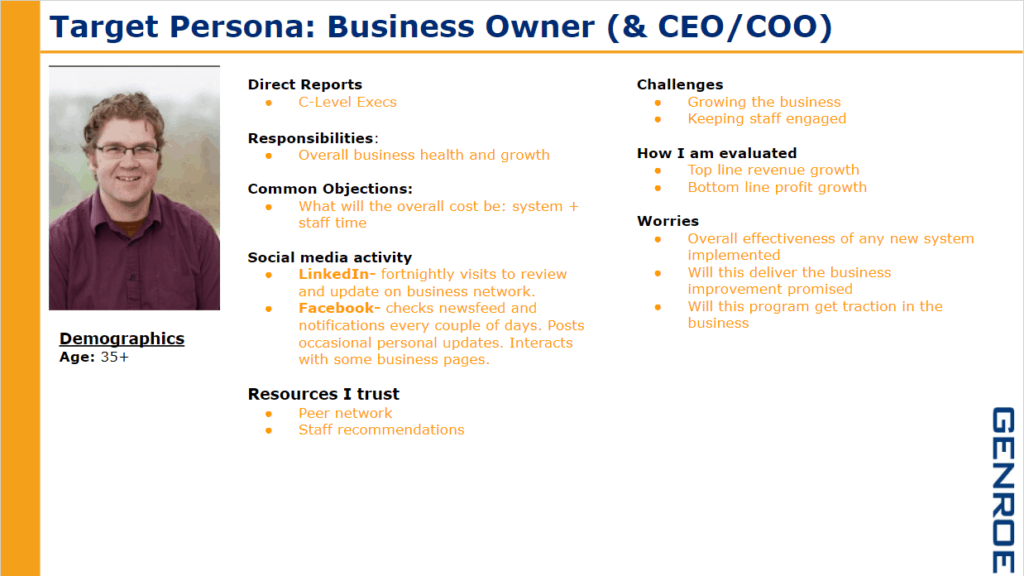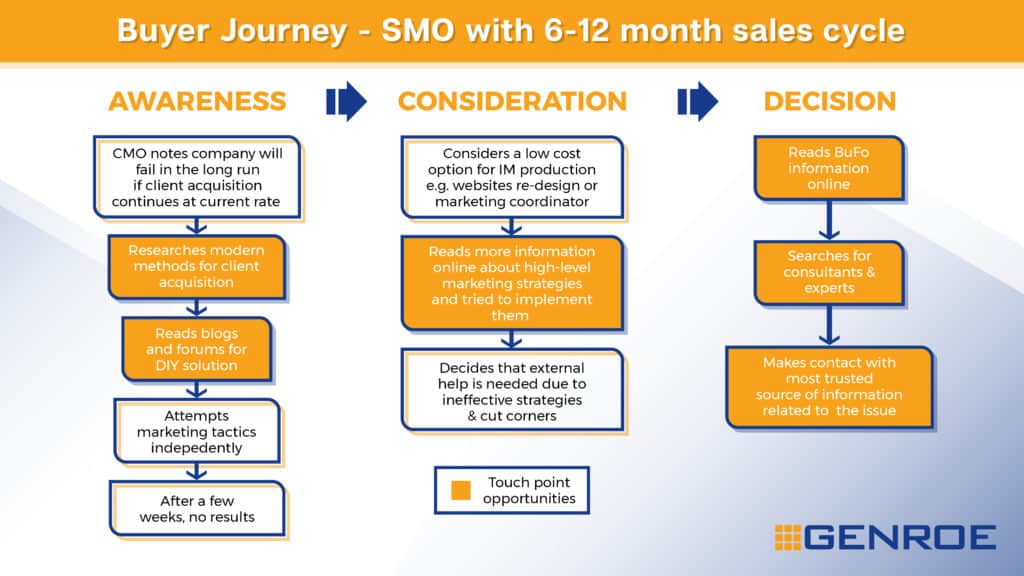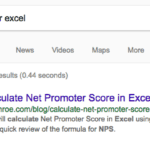Inbound marketing has been driving traffic, leads and customers businesses for over a decade now. Until recently it was more commonly called Content Marketing.
It’s the idea that you should build a relationship with your customers by helping them and educating them on their problem and the solutions before you sell to them on your B2B business.
In this post we’ll examine some of the basic tenants of Inbound Marketing and how you can convert your marketing process to take advantage of this approach.
What is the difference between outbound and inbound marketing?
Converting to inbound is a gradual process that isn’t going to remove your ability to maintain some outbound activity.
The table below shows the differences between the two methodologies and you’ll see that it’s very possible to perform both outbound and inbound marketing activities within your business.
| Inbound Methodology | Outbound Methodology |
| Based on a buyer’s journey | More like advertising |
| Made up of high value content creation | Made of up of ads and aggressive sales |
| A smaller more specific audience | Involves a buyer persona but no detailed buyer’s journey |
| Costs less in the long term | Wider audience |
| More passive compared to outbound | A process involving active outreach |
| Tools include emails, blogs, landing pages, forms, downloadables, webinars | Tools include expos, trade shows, cold calling, paid advertising |
Take small and measured steps and there’s minimal risk involved in shifting your strategy to the inbound methodology.
You can even use outbound to support inbound, for example, you might have blog content that you advertise, or blogs that talk about upcoming expos and vice versa.

Convert to Inbound with a Buyer’s Persona
The inbound methodology starts with your existing, or target clients profiles and then identifies their needs and problems.
For example, if you are an IT services business providing servicing, maintenance and hosting, you could have a client that only requires hosting. They already have an IT team which provides servicing and maintenance.
You have another client that requires all three but is so small that they can only afford servicing.
From these two clients you may decide that your ideal business persona is one that has only an IT manager with no IT team, but has sufficient revenue per annum to afford all three offerings.
In this scenario the type of business you prefer to work with has been narrowed down as well as the buyer persona of which there will be two, the IT Manager/CTO and the CEO.
As existing clients that are hopefully happy with the service they are currently receiving from your business, it should be relatively simple to find out more about their business and how it runs.
If you don’t have sufficient information, you can send all your clients a short survey with no more than 10 questions. Call them up personally to ask them to fill it out. You can be direct and honest with them and say it’s to improve your marketing efforts and to find out how you can be a better service/product provider.

How it looks in outbound: At this stage, there is little difference between the two. To advertise effectively, you need to know who you are advertising to so you can use text and imagery that will speak to the person you are advertising to.
Chart out your Buyer’s Journey
Understand that there are three main stages in a buyer’s journey:
Awareness: When your potential buyer is aware of their problem, or what we refer to as a pain point. They may not have put an exact name to their problem yet now will they know of how to fix it.
How you speak to buyers in awareness: Help them to better understand what their problems are by providing content on what their problems could be and how to accurately diagnose it.

Consideration: You potential buyer now understands what their problem is and is looking for solutions.
How you speak to buyer’s in consideration: Provide highly informative content the different ways that these problems can be fixed, what could happen after fixing, what could happen if their issues aren’t fixed and how they could attempt to fix it themselves.
Decision: Your potential buyer has decided on what kind of solution they would like to pursue have likely short listed you as a potential supplier. They want more specific information about their shortlisted suppliers that can help them decide on which supplier to go with.
How to speak to buyer’s in consideration: Provide information that elicits trust in your company. This includes white papers, reviews, testimonials, case studies and depending on your sales people, it could also be where you start to make direct contact and provide more personalised information based on their exact needs. This includes proposals, automated quotations, and all your service web pages. These pages are also called high-value pages, because people who visit and convert on them are most likely to be in the decision stage.
What this looks like in outbound: This is where the two diverge drastically. Outbound marketing methods usually start at the decision stage with advertising focused on converting people who already want to buy.
The problem with this is that you haven’t had much time with your prospect to build trust. So instead of you selling yourself on how well you know your subject matter, you’re competing for advertising space and it becomes a who has the biggest billboard competition. This might work for the big wigs, but smaller companies will need to shell out a lot more money into their advertising to compete.
Buyer’s Journey builds a Marketing Funnel
A buyer’s journey exemplifies what your buyer is thinking in the stages leading up to their purchase, while a marketing funnel contains your strategy for content in response to your buyer’s journey.
Now that you have a better idea of your buyer’s journey, you can start creating content that speaks to them at each stage. The industry standard for this is to ensure that your buyer has 6 different opportunities to come across your content during their journey. So make sure you have sufficient content for each stage so that this can happen.
What this looks like in outbound: Marketing funnels don’t exist at all in outbound. What takes place instead is a sales funnel which involves different levels of direct contact between sales people and the potential buyer. At this point, sales leads are separated into those who are most likely to buy, and those who have given reasons for why they aren’t interested.
Convert to Inbound by Creating Content
If you are currently performing the outbound methodology, you most likely already have some decision making content, mentioned earlier.
The content commonly used for Awareness and Consideration consists of the following.
- Search Engine Optimised Blogs – To attract people to your website
- CTA’s – Buttons or links on your blog that offer some enticing content
- Landing pages – That describe the enticing content in more detail and forms that require a few personal details to be submitted in exchange for the enticing content.
- Thank You Pages – which thank the prospect for submitting their details and also provides the promised content.
- Gated Content – This is the content itself which needs to be related to the subject matter of the blog post to increase the chances of people wanting to click on it.
Blogs
The main type of content you want to start building regularly when converting to inbound is blogs. They can be used to target buyers at all stages of the journey. You can host your blog on WordPress, it’s one of the cheapest and easiest ways to get a blog started. If you choose this option, use good quality web hosting for WordPress – low cost options are often a false economy.
The best practice for blogs is to publish a new one every week on the same date so that Google sees your site as a consistent source of valued information within a specific subject matter. To track your visitors and understand their behaviours on your website and blog, you need to set up a Google Analytics account.
The information you get from Google Analytics includes:
- Unique page visits – how many times a new person visits a particular page
- Page duration – How long the average stays on a page before leaving
- Bounce rate – how many people visit your page and leave immediately
- Location – Where your visitors are based
Gated Content
You only need a few pieces of gated content that you can use multiple times on different blogs. At the very least, you need one piece of gated content for each stage of the buyer’s journey. But as you progress you can A/B test the success of your gated content and have two or three pieces of gated content for each stage.
To host gated content, you will need to invest in a couple of tools including a landing page and form platform such as Lead Pages. These platforms are usually quite cost-effective when making the move from outbound to inbound as you only pay for what you use. Over time as you start to use more and more landing pages and forms, it will become more cost-effective to use an end-to-end CRM (Customer Relationship Manager) such as Hubspot.







